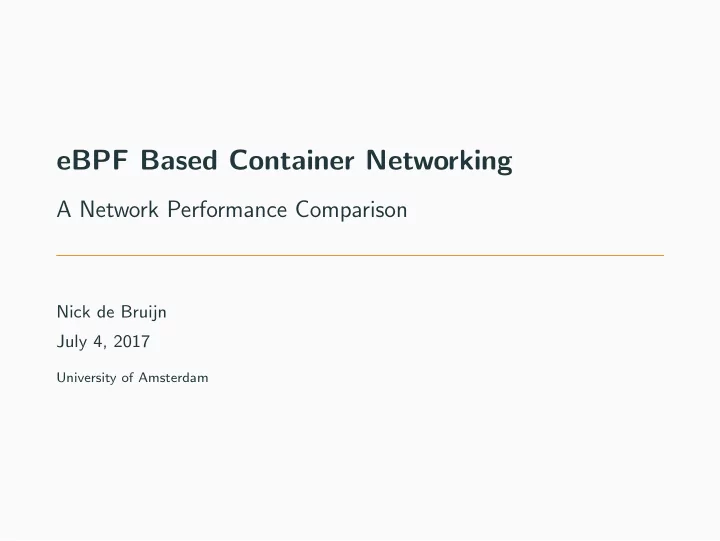

eBPF Based Container Networking A Network Performance Comparison Nick de Bruijn July 4, 2017 University of Amsterdam
Introduction Figure 1: Microservices and Containers 1 1 https://www.slideshare.net/Docker/cilium-network-and-application-security-with- bpf-and-xdp-thomas-graf-covalent-io 1/28
Introduction - Iptables Iptables: • $ iptables -A INPUT -p tcp -s 10.0.0.23 –dport 80 -m conntrack –ctstate NEW -j ACCEPT 2/28
Research Goal Research goal: • Evaluate the usability of Cilium as a packet filtering system in a container (Microservices) infrastructure. 3/28
Research Questions • What throughput and latency we get in the case of using Cilium’s eBPF program and Linux’s Iptables as packet filter? • What effect does the number of security policies have on the throughput and latency in both cases? • Is there a turn point in performance when increasing the number of security policies? 4/28
Background 5/28
Docker Networking • Endpoints (Container eth0) • Virtual Ethernet devices (veth) • Bridge on the host (docker0) 1 Figure: https://success.docker.com/Architecture/Docker R eference A rchitecture 6/28
Docker Networking - Communication • Endpoints (Container eth0) • Virtual Ethernet devices (veth) • Bridge on the host (docker0) Packet filtering: • On container 7/28
Docker Networking - Communication Components: • Endpoints (Container eth0) • Virtual Ethernet devices (veth) • Bridge on the host (docker0) Packet filtering: • On container • On the bridge 8/28
Iptables - Performance penalty? 2 • Uses chains with rules • Each chain contains 0 or more rules • Top down approach • Checks until match is found • So placement is important 2 Figure: http://www.iptables.info/en/structure-of-iptables.html 9/28
What is Cilium? • Opensource project • Adds a layer on top of the existing container environment (Docker) • To improve container networking and policy enforcement • No Iptables / bridges • Relies on eBPF programs 10/28
What is eBPF (extended Berkeley Packet Filter)? eBPF is used to extend the functionality of the kernel at runtime. • It’s effectively a small kernel based machine • 10 64bit registers • 512 byte stack • Data structures are known as maps • Has a verifier to ensure the program is safe • No loops, max 4k instructions, no more then 64 maps. 11/28
eBPF Figure 2: eBPF Overview 3 3 https://www.slideshare.net/Docker/cilium-bpf-xdp-for-containers-66969823 12/28
extended Berkley Packet Filter - Functionality 1. Rewrite packet content 2. Extend/trim packet size 3. Redirect to other netdevices 4. Enforce policies 5. On the fly program generation 13/28
Cilium - Network with eBPF Figure 3: eBPF with Cilium 4 14/28 4 https://www.slideshare.net/Docker/cilium-bpf-xdp-for-containers-66969823
Cilium - Policies Figure 4: Cilium Policy Using Json 15/28
Approach 16/28
Approach - Docker environment 17/28
Approach - Cilium environment 18/28
Approach - Scenario Performed tests on two scenarios: • Localhost • And Multi-host For each scenario we are interested in: • The throughput and latency with no additional policies/rules. • The change in performance whenever we start to increase the number of policies/rules. 19/28
Approach - Experiments • Using Iperf3 to send a TCP STREAM • Using Netperf to send a TCP RR (Request Response) • Every test runs 1 minute. Every test is performed 10 times to determine the variation • Every test runs with 0, 1, 5, 10, 25, 50, 100, and 200 policies 20/28
Results 21/28
Results - Throughput Localhost Figure 5: Throughput - localhost (Higher is better) • Cilium’s eBPF approach outperforms the IPtable approach. • Number of Cilium policies does not affect the throughput • Number of no matching Iptables rules greatly affect the throughput 22/28
Results - Latency Localhost Figure 6: TCP Latency - localhost (Lower is better) • Same observation as the throughput • Cilium’s eBPF approach has a lower latency 23/28
Results - Throughput Remote Containers Figure 7: TCP Throughput - Remote Host (Higher is better) • Different observation than on Localhost • Cilium’s eBPF seems to perform less • Iptables show no performs penalty until 1000 policies 24/28
Results - Latency Remote Containers Figure 8: TCP Latency - Remote Host (Lower is better) • Same observation as the remote throughput • Cilium’s eBPF approach has a higher latency 25/28
Conclusion 26/28
Conclusion Overal: 1. Cilium seems like a promising project. 2. We can define L3, L4, and L7 policies Performance wise: 1. The performance is not influenced by number of policies. 2. Cilium shows to perform better in the situation of local containers. 3. Room for improvements for multi-host enviornments 27/28
Open issues & Future work • Test the VXLAN overlay overhead used by Docker and Cilium • Do Kernel traces to get a better understanding of which path packets take in the kernel. • Optimize both approaches to see what the best possible throughput and latency can be reached for each approach. • Test Cilium using XDP to offload the system. 28/28
Thank you for your attention, Questions? 28/28
Recommend
More recommend